Effective enrichment strategies for broilers
Published: May 10, 2021
By: Gracie Anderson, MS student, Virginia Tech. Reviewers: Dr. Leonie Jacobs, Virginia Tech; Dr. Prafulla Regmi, North Carolina State University; Dr. Marisa Erasmus, Purdue University; Dr. Shawna Weimer, University of Maryland.

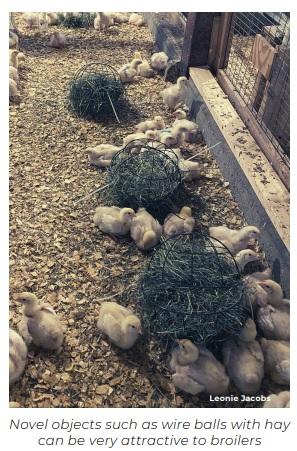 Modifications to broiler chicken housing to improve animal welfare
Modifications to broiler chicken housing to improve animal welfareConventional housing of broiler chickens raises concern for their welfare. High stocking densities and barren environments have the potential to contribute to lameness, skin lesions (i.e., hock burns, breast burns, footpad dermatitis*), heat stress, and increased fear that, in turn, can result in piling up and mortality.
Environmental enrichment can mitigate these welfare concerns by increasing activity levels and allowing for opportunities to perform species-specific behaviors which are important to ensure good welfare.
Studies investigating different types of enrichments have found a positive effect on broiler welfare due to a more varied behavioral repertoire and decreased laying time.
Some effective enrichments included in this newsletter are: elevated platforms, panels or barriers, straw bales, sand or roughage, and novel objects.
*Hock burns, breast burns and footpad dermatitis are brown/black skin lesions (necrosis) due to prolonged contact with litter.

Key characteristics of successful enrichments
- Increase species-specific (natural) behaviors
- Maintain or improve levels of health
- Improve economics of the production system
- Practical to employ
- Add environmental complexity
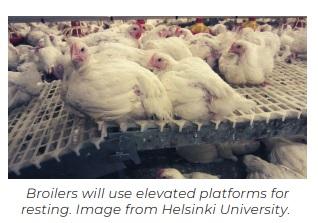
Elevated platforms
Even after years of strong genetic selection, domestic chickens are motivated to exhibit certain species-specific behaviors, including resting on elevated surfaces.
One way of fulfilling this need is to provide an elevated platform, often consisting of raised plastic slatted areas accessible by ramps. Broilers have shown a preference for raised platforms over perches, probably because platforms are easier to access and balance on compared to perches.
However, use of these structures largely depends on stocking density, design, accessibility, bird age, and their physical condition. It is important to keep in mind that birds are motivated to show perching behavior, but might not be able to do so.

Panels or barriers
Broilers commonly rest along the walls of the house, possibly to seek protection while sleeping. This can be an issue, as an uneven distribution of birds in the house can lead to reduced litter quality in those heavily-used areas (increased moisture and noxious chemicals), which can lead to contact dermatitis.
Additionally, when birds kept at high stocking densities gather to rest in a localized part of the house, you can expect an increase in disturbances of resting birds from those who attempt to move to another location.
Therefore, a more evenly distributed flock can be achieved by providing panels or barriers in the middle of the house.
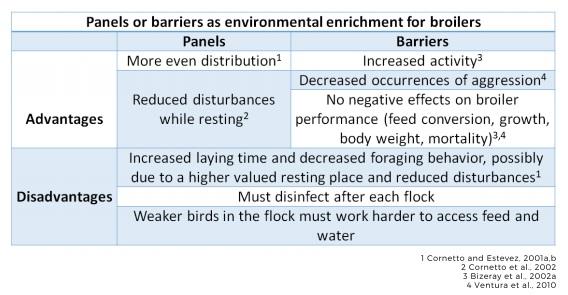
Straw bales
Bales of substrate, such as straw or even bundles of wood shavings, can be used to stimulate activity and exploratory behavior in addition to providing a sense of protection while resting.

Sand or roughage
Two important natural (species-specific) behaviors of broiler chickens are foraging and dustbathing. Providing sand or other substrates (like peat, oat husks, or roughage) have been proven to increase time spent on these behaviors. It is possible to provide these substrates within a shallow wooden box or metal rings distributed evenly throughout the house.
Novel objects
Increasing the complexity of the environment reduces fear in poultry, thus improves animal welfare. This can be achieved by the provision of novel objects, such as colored plastic balls, plastic bottles, mirrors, hanging bundles of string, or other colorful items. The purpose of a novel object is to stimulate exploratory behavior and activity, and possibly inducing play behavior. Broilers will be less fearful towards humans when they have had access to a variety of novel objects.
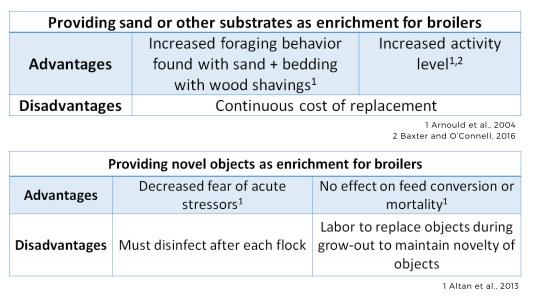
Final notes
In summary, providing environmental enrichment has many benefits for broiler health. In addition, these enrichments have the potential to increase species-specific behaviors, therefore improving welfare.
However, much is unknown about how stocking density impacts the positive effect of enrichment. Location and number of enrichments is an important factor to consider, as too few enrichments could result in crowding, competition over resources, or may only benefit a small number of birds.
While the mentioned enrichments are shown to have beneficial effects on broiler chicken welfare, it is important to note that research is ongoing to determine effects of specific enrichments on certain aspects of broiler health and productivity.
This article was originally published on Poultry Extension Collaborative (PEC) and it is reproduced here with permission from the authors.
References
Major source for the content of this newsletter, and recommended reading: Riber, A. B., H. A. van de Weerd, I. C. de Jong, and S. Steenfeldt. 2018. Review of environmental enrichment for broiler chickens. Poult. Sci. 97:378–396. Available at http://academic.oup.com/ps/article/97/2/378/4683676.
References used
Ö. Altan, C. Seremet, H. Bayraktar. The effect of early environmental enrichment on performance, fear and physiological responses to acute stress of broiler. Arch. Geflügelkd., 77 (2013), pp. 23-28.
C. Arnould, D. Bizeray, J.M. Faure, C. Leterrier. Effects of the addition of sand and string to pens on use of space, activity, tarsal angulations and bone composition in broiler chickens. Anim. Welf., 13 (2004), pp. 87-94.
C.L. Bailie, M.E.E Ball, N.E. O’Connell. Influence of the provision of natural light and straw bales on activity levels and leg health in commercial broiler chickens. Animal., 7 (2013), pp. 618-626.
C.L.Bailie, O’Connell N.E., 2016. Perch design preferences of commercial broiler chickens reared in windowed houses. Proc. EAAP 67th Annual Meeting. Aug. 29-Sept. 1, Belfast, Ireland. P397.
A.W. Bassler, C. Arnould, A. Butterworth, L. Colin, I.C. de Jon, V. Ferrante, P. Ferrari, S. Haslam, F. Wemelsfelder, H.H. Blokhuis. Potential risk factors associated with contact dermatitis, lameness, negative emotional state, and fear of humans in broiler chicken flocks. Poult. Sci., 92 (2013), pp. 2811-2826.
C.L. Bailie, N.E. O’Connell. The effect of level of straw bale provision on the behavior and leg health of commercial broiler chickens. Animal., 8 (2014), pp. 1715-1721.
M. Baxter, O’Connell, N. E., 2016. Commercial comparison of potential dustbathing substrates for intensively farmed broilers. Proc. EAAP 67th Annual Meeting. Aug. 29-Sept. 1, Belfast, Ireland. P398.
W. Bessei. Welfare of Broilers: a review. W. Poult. Sci. J., 62 (2006), pp. 455-466.
D. Bizeray, I. Estevez, C. Leterrier, J.M. Faure. Effects of increasing environmental complexity on the physical activity of broiler chickens. Appl. Anim. Behav. Sci., 79 (2002), pp. 27-41.
E.A.M. Bokkers, P. Koene. Behavior of fast- and slow-growing broilers to 12 weeks of age and the physical consequences. Appl. Anim. Behav. Sci., 81 (2003), pp. 59-72.
R.H. Bradshaw, R.D. Kirkden, D.M. Broom. A review of the aetiology and pathology of leg weakness in broilers in relation to welfare. Avian Poult. Biol. Rev., 13 (2002), pp. 45-103.
T. Cornetto, I. Estevez. Behavior of the domestic fowl in the presence of vertical panels. Poult. Sci., 80 (2001), pp. 1455-1462.
T. Cornetto, I. Estevez. Influence of vertical panels on use of space by domestic fowl. Appl. Anim. Behav. Sci., 71 (2001), pp. 141-153.
T. Cornetto, I. Estevez, L.W. Douglass. Using artificial cover to reduce aggression and disturbances in domestic fowl. Appl. Anim. Behav. Sci., 75 (2002), pp. 325-336.
M.S. Dawkins, C.A. Donnelly, T.A. Jones. Chicken welfare is influenced more by housing conditions than by stocking density. Nature., 427 (2004), pp. 342-344.
EFSA. Scientific opinion on the influence of genetic parameters on the welfare and the resistance to stress of commercial broilers. EFSA J., 8 (2010), p. 1666. Doi.10.2903/j.efsa.2010.1666
A.L. Hall. The effect of stocking density on the welfare and behavior of broiler chickens reared commercially. Anim. Welf., 10 (2001), pp. 23-40.
R.B. Jones. 1989. Development and alleviation of fear. Proc. 3rd European Symposium on Poultry Welfare. Tours, France. P123-136.
E. Kaukonen, Norring M., Valros A., 2016. Using elevated platforms to improve broiler leg health on commercial broiler farms. Proc. 50th Congress of the International Society of Applied Ethology. June 12-15, Edinburgh, UK. P228.
A. Kells, M.S. Dawkins, M.C. Borja. The effect of ‘freedom food’ enrichment on the behavior of broilers on commercial farms. Anim. Welf., 10 (2001), pp. 347-356.
U. Knierim. Effects of stocking density on the behavior and bodily state of broilers fattened with a target live weight of 2 kg. Berl. Munch. Tierarztl. Wochensch., 126 (2013), pp. 149-155.
B.L. Neilson. Breast blisters in groups of slow-growing broilers in relation to strain and the availability and use of perches. Br. Poult. Sci., 45 (2004), pp. 306-315.
R.C. Newberry. Environmental enrichment – increasing the biological relevance of captive environments. Appl. Anim. Behav. Sci., 44 (1995), pp. 229-243.
R.C. Newberry, D.M. Shackleton. Use of visual cover by domestic fowl: A Venetian blind effect? Anim. Behav., 54 (1997), pp. 387-395.
K. Reiter, W. Bessei. Effect of stocking density of broilers on temperature in the litter and at bird level. Arch. Geflügelkd., 64 (2000), pp. 204-206.
A.B. Riber, H.A. Van de Weerd, I.C. de Jong, S. Steenfeldt. Review of environmental enrichment for broiler chickens. Poult. Sci. J., 97 (2018), pp. 378-396.
V. Sandilands, C. Moinard, N.H.C. Sparks. Providing laying hens with perches: fulfilling behavioral needs but causing injury? Br. Poult. Sci., 50 (2009), pp. 395-406.
S. Syafwan, R.P. Kwakkel, M.W.A. Verstegen. Heat stress and feeding strategies in meat-type chickens. World. Poult. Sci. J., 67 (2011), pp. 653-673.
H.A. Van de Weerd, J. Day. A review of environmental enrichment for pigs housed in intensive housing systems. Appl. Anim. Behav. Sci., 116 (2009), pp. 1-20.
B.A. Ventura, F. Siewerdt, I. Estevez. Effects of barrier perches and density on broiler leg health, fear, and performance. Poult. Sci., 89 (2010), pp. 1574-1583.
B.A. Ventura, F. Siewerdt, I. Estevez. Access to barrier perches improves behavior repertoire in broilers. PLoS ONE, 7 (2012), p. e29826.
Related topics
Authors:
Show more
Join to be able to comment.
Once you join Engormix, you will be able to participate in all content and forums.
* Required information
Would you like to discuss another topic? Create a new post to engage with experts in the community.
Create a post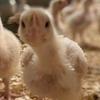










.jpg&w=3840&q=75)